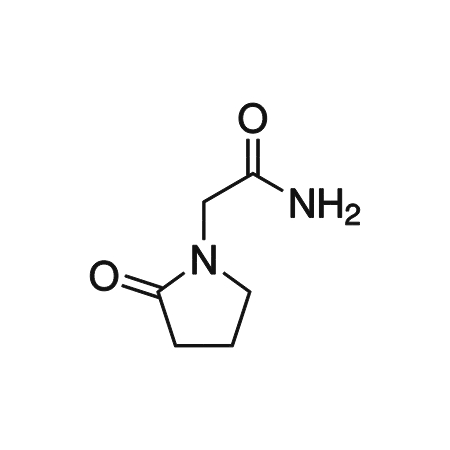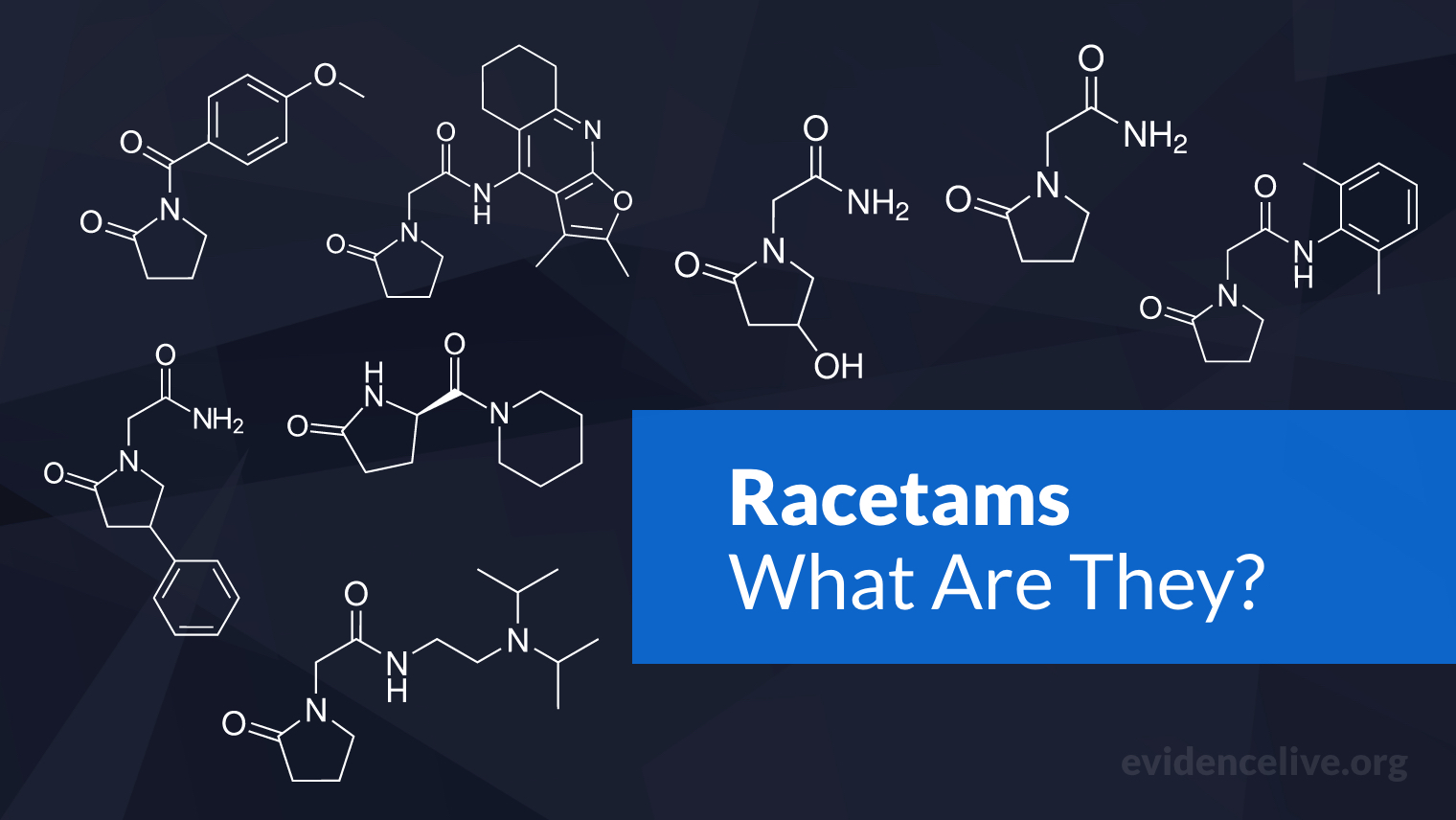Are you wondering what you can do to improve your mind? Racetams are a tried-and-true class of synthetic nootropics that offer a plethora of remarkable properties.
However, it is sometimes hard to find information about the effectiveness and actions of each type.
Without that information, you wouldn’t know which racetam will work for you. So, before we get to the types, let’s look at the similarities that tie them all together.
Contents
What Are Racetams?
Racetams are a class of drugs that are related through a shared pyrrolidone nucleus. Since the synthetization of the first racetam in the 1960s, dozens of derivatives have been developed.
Many racetams are available by prescription in countries around the globe. Depending on the specific compound, they may be prescribed for dementia, stroke recovery, ADHD, and epilepsy.
The United States classifies racetams differently than many other dietary supplements. Racetams are only available for research purposes. However, you can still get them without a prescription.
Each type of racetam holds enough distinct features to put them in different classes of drugs.
Some work as smart drugs, while others are anticonvulsants. However, they still have similarities in their mechanism of action.
How Do Racetams Work?
All racetams work by activating the central nervous system receptors that exist in cells with cholinergic receptors. This is important because the neurotransmitters glutamate and acetylcholine are essential for cognitive function and proper receptor function.
Glutamate receptors are essential in regulating many bodily processes.
The neurotransmitter glutamate is found in high concentrations within the nervous system and the brain, and it is a precursor for gamma-aminobutyric acid (GABA).
This is crucial to the mechanisms of racetams because GABA is necessary for various brain and body results.
The action on the neurotransmitter acetylcholine is made possible by the effects on choline acetyltransferase and the acetylcholine receptors.
Acetylcholine is one of the neurotransmitters responsible for influencing the parasympathetic nervous system and offers functions responsible for stress response.
Acetylcholine also signals muscle movement and communication. Therefore, it is essential for cognition and helps us apply learned information and memories by making connections in the brain.
The Top 8 Racetam Nootropics
There are dozens of compounds in the racetam family, but they are not all equal when the quality and potency are concerned.
Nevertheless, these eight are considered the best racetams for brain health and cognitive function:
- Piracetam
- Aniracetam
- Fasoracetam
- Oxiracetam
- Phenylpiracetam
- Pramiracetam
- Coluracetam
- Nefiracetam
Piracetam
Piracetam was the first racetam drug and the first to be defined as a nootropic. Piracetam was synthesized to be used for motion sickness. However, the impact on GABA, AMPA receptors, and ACh receptors works for brain health and cognition.
Research shows that piracetam has a beneficial impact on brain function and cognition because it readily allows choline to pass through the blood-brain barrier.
In addition, several studies show that piracetam can help with learning and performance when completing tasks (1).

In addition, piracetam may boost a person’s ability to focus so much that it can even reduce symptoms of dyslexia.
Since piracetam can help with dyslexia, some scientists and researchers believe it may be beneficial for other learning disorders or even help with information gathering and processing in people with otherwise normal learning abilities and brain development.
Piracetam may also act as an anticonvulsant and could help people prevent muscle spasms and seizures.
Also, studies show that piracetam can improve symptoms related to myoclonic attacks. One study even showed that piracetam improved daily task completion (2).
There is also evidence that shows that piracetam has neuroprotective properties. Research studies show that piracetam can improve symptoms associated with Alzheimer’s disease and other forms of dementia.
It helped to reduce forgetfulness by impacting brain memory functions. Some scientists even believe that it could aid in the prevention of age-related cognitive decline.
Piracetam is one of the most well-studied nootropics available because it has been around for so long.
However, it is not as potent as some alternatives, and some users are disappointed with the underwhelming effects. Furthermore, piracetam doesn’t entirely work until two to three weeks of daily dosing and regular use.
The recommended dosage of piracetam is 1,300 to 1,600 mg 2 to 3 times per day.
Aniracetam
Aniracetam is a very popular racetam because it can increase cell signaling in the brain and make glutamate more effective. These processes handle the nootropic effects of aniracetam (3).
Aniracetam is known for significantly improving focus and concentration. This means that it can allow you to work for a more extended period of time, increasing productivity. Aniracetam also builds up in the system so that these properties last without changing dosage levels.
Aniracetam also releases a substantial amount of acetylcholine in the brain, which helps memory and information recall.

Some find that aniracetam even has mild stimulant properties that can add to these beneficial effects and may help to reduce the impact of brain fog. Aniracetam is also one of the more popular racetams for boosting creativity.
Aniracetam differs from some other racetams because it is also suitable for mental health. It offers an anxiolytic effect. Animal studies have found that it can reduce signs of anxiety in rats. While human studies are needed, the chemical profile and effects are promising.
Clinical studies also show that aniracetam may help some people with symptoms of depression. The improvements in mental health are thought to be caused by the serotonin and dopamine receptors, which help regulate mood, appetite, weight, and sleep.
Like other racetams, aniracetam may also benefit people with Alzheimer’s disease, dementia, and other cognitive impairment. This is because it has a positive effect on learning and memory.
More extensive clinical studies are necessary to confirm these results, but the studies on other racetams, like piracetam, help to show that this could be a benefit. However, it is important to note that research for the effects is limited, and some users report no significant impact.
The recommended dosage of aniracetam is 750 mg two times per day.
Fasoracetam
Fasoracetam is a nootropic that primarily works on the GABA receptors, making it an excellent choice for mood enhancement.
In addition, study findings on the mechanism of action for fasoracetam may show that the antidepressant effects could be long-lasting compared with other nootropics that work for mood (4).
Fasoracetam also improves cognition, but the effect is not as significant as other nootropic options. Still, it can improve focus in people who get easily distracted, such as those who suffer from ADHD.
It can also help with attention span in some users, but more research needs to be done to see the effectiveness of fasoracetam for cognition.
Some reviews report fasoracetam had a stimulatory effect on them, except without the downsides like being overly alert and restless.
This could help someone battle through the brain fog, utilize their mental capacities, and allows users to use their brains at optimal levels, which aids with cognitive performance.
Fasoracetam may also help with cognitive decline. Although, the impact doesn’t seem to be as great as it is in the study of other nootropics. In fact, the research for fasoracetam’s beneficial uses lacks in virtually every way.
Still, many like to combine fasoracetam with supplements to increase the proposed benefits of their nootropic stack.
Fasoracetam is more potent than some of the other racetams, and a dose could be effective at doses as low as 20 to 40 mg. However, typically users will take doses between 100 and 200 mg, once or twice per day.
Oxiracetam
Oxiracetam is one of the older members of the racetam family and is a direct derivative of piracetam. While oxiracetam works similarly, the research for its use in memory enhancement is promising, and it seems to offer a lower risk of side effects than some of the alternatives.
Study results show that oxiracetam may be effective for the treatment of cognitive decline caused by cerebrovascular problems.
Our brain needs blood flow for proper cognitive function, and oxiracetam may help stroke patients with impairments related to damage in the brain.
While this activity of oxiracetam has only been shown in rats, some experts believe that the effect would be the same for human consumption of the substance (5).
The potential nootropic effect of oxiracetam for the improvement of cognition in otherwise healthy subjects has less evidence. However, students sometimes use oxiracetam supplementation to study and to increase performance.
Oxiracetam also acts as a mild stimulant and can help to provide more energy to your body and brain cells. The stimulant experience may also give a boost in mood. The efficacy for energy usage seems to depend on the genetic structure or personality of the user.
However, some say that oxiracetam’s mood and energy-boosting activity is intense when combined with other nootropics.
Oxiracetam may also help with motivation and may help someone with learning new information because it reduces boredom. Many people like to take oxiracetam before study sessions because it helps them focus on dull or tedious tasks in the student population.
Oxiracetam may even help you retain information longer because you can concentrate on the task at hand.
Many of these findings are likely related to the increase in neurotransmission speed that oxiracetam causes. When the neurons in our brains communicate rapidly using their synapses, we are likely to improve cognitive function.
Experts in neurobiology believe that this may be helpful in the treatment of traumatic brain injuries and the resulting amnesia.
The recommended dosage of oxiracetam is 750 to 1,500 mg per day, divided into two doses.
Phenylpiracetam
Phenylpiracetam was developed in the early 80s to help Soviet Cosmonauts with the stress of a space flight and boost physical and mental abilities.
Despite having a lack of research on the effects of phenylpiracetam with mice and other animal models, many people still add it to their nootropic supplement stacks to boost effects (6).
Comparing with other racetam compounds, phenylpiracetam offers more potential as a supplement for physical accomplishment.
In fact, the World Anti-Doping Agency even includes phenylpiracetam on the banned substances list because of its use as a performance-enhancing drug.
In addition, phenylpiracetam aids in the delivery of oxygen and nutrients to the brain and body.
While this may be important for its use in athletic situations, this interaction may also help provide nootropic effects and help with alertness and focus while helping someone pay attention.
According to one source, phenylpiracetam can also help reduce or even ease anxiety, stress, and depression symptoms.
In addition, this racetam holds a stronger affinity for GABA than other racetams, and it is often used for supplementation with stimulants to help with negative reactions.
The analysis of these effects shows phenylpiracetam may even be an anti-convulsive with decent potency.
Thus, it may be strong even to combine with epilepsy treatments to increase the effectiveness of the available treatment options.
Neurohackers strongly believe in the potency and quality of phenylpiracetam because it offers rapid nootropic effects. It may help with the fluidity of mental thoughts and can even boost memory formation.
The recommended dose of phenylpiracetam is 100 mg once to twice per day.
Pramiracetam
Pramiracetam offers a vast number of nootropic effects, and the research shows that it may be beneficial for humans and not just rats and mice.
Evidence suggests that pramiracetam may help with memory loss, behavior, amnesia, and other problems with cognition caused by head injuries or anoxia (7).
Pramiracetam does not work well for stress, anxiety, and depression and may worsen these mental health disorders.
This is because it has no impact on GABA production, dopamine, norepinephrine, or serotonin.
Pramiracetam acts as a stimulant which can be great for increasing a sense of self-esteem and improving confidence. It may help to put someone in a productive state of mind and help with productivity.
Some people experience an increase in feelings of control because of the difference between this cognitive-enhancer and other racetams or nootropic drugs.
The activity in rats shows it may be suitable for those who suffer from memory loss.
While the long-term impact of memory has yet to be studied, studies show that acute transmission of pramiracetam may help with the treatment of amnesia, especially when combined with other beneficial drugs.
A review of users will tell you it may help sharpen focus or stimulate a train of thought.
The modulation of the thinking process and the control of attention and motivation make pramiracetam one of the more popular supplements for completing analytical or tedious work.
It may even help with verbal communication and numerical selection, and calculation.
The recommended dosage of pramiracetam is 250 to 400 mg 1 to 3 times per day, with the dosages separated by at least 3 hours
Coluracetam
Coluracetam is one of the more recent additions to the racetam family and was created in 2005. It works primarily on the high-affinity choline uptake process, which is necessary for learning and memory (8).
Not only can coluracetam help with a range of memory problems, especially related to low choline levels, but it can also help with focus and concentration.
Because of its recent development, it is still one of the lesser-known racetams, but those who use it find that it allows them to pay attention for longer without losing interest.
Coluracetam also offers some unique effects on perception and sensation. For example, the study of coluracetam tells us it can enhance sound and color.
Many prefer these effects because it allows them to concentrate more on the quality of their work. Other people, however, find that these effects of the drug are distracting and do not add any effectiveness.
Coluracetam may also help with symptoms associated with anxiety and depression.
Still, because it is very new compared to alternatives, there is not very much scientific evidence that shows the interaction that users have with the ingestion of the racetam.
However, it seems to be a potential therapeutic drug for schizophrenia. This is because it helps with chemical regulations within the brain, and meager amounts of several chemicals, including acetylcholine, are found in those who suffer from schizophrenia.
The recommended dosage of coluracetam is 20 to 80 mg once or twice per day.
Nefiracetam
Nefiracetam was developed because of its behavior on cerebrovascular disorders and now offers some additional benefits. The impact on blood flow and vascular health may help to provide a boost to overall cognition.
Nefiracetam also improved neuroplasticity, which can help with positive mental changes. When a neuron changes, it can help to improve memory and the ability to recall information that was processed at an earlier time.
Nefiracetam also provides a calming effect that could be beneficial for those who suffer from anxiety.
Unfortunately, people who have anxiety are often hesitant to try nootropics because many can increase their symptoms. On the other hand, nefiracetam is an increasingly popular choice because of the ability to calm and relax the body while simultaneously offering increased focus.
Nefiracetam also stabilizes mood and can alleviate mood swings. This impact can also help someone improve their social skills because they will be less prone to emotional reactions. It is also a superb choice for those who suffer from depression.
Also, people who take nefiracetam find they can easily articulate their thoughts. This helps with symptoms of mental fatigue. Users may even report less apathy when consuming a supplement containing nefiracetam.
Finally, the behavior of nefiracetam may make colors and sounds more vibrant. Some believe that this effect is partially responsible for the boost in the mood because everything appears to be more beautiful, which can provide a sense of euphoria.
The recommended dose of nefiracetam is up to 900 mg per day, divided into a small dose in the morning and another at around noon.
Do Racetams Have Side Effects?
While racetams are typically considered safe to use, there are several side effects to be aware of to control your dose and ensure that you are safe.
Some minor side effects include tiredness, dizziness, headaches, diarrhea, nausea, and high blood pressure.
If you experience hyperactivity or insomnia, you may want to decrease the frequency of your doses. Many find that they only have insomnia when they take racetams too late in the day.
Racetams can also cause some overdose symptoms when you reach toxicity levels that include odd behavior, headaches, extreme fatigue, irritability, foggy thinking, and sensory overload.
Some racetams also have anti-clotting effects, and it is best to avoid them if you are on a blood-thinning drug. Combining the two could lead to damage sometimes.
Finally, many racetams only work well when combined with choline supplements. Doing this may be beneficial but can also increase the risk of side effects.
Racetams are not approved by the FDA, and many can only be used for research and are not sold as a form of dietary supplement.
Conclusion
While racetams may provide nootropic benefits and boost memory and learning, there is a significant lack of evidence for their benefits.
Furthermore, since they are synthetic compounds, there should be some hesitancy to consume them before research.
They are still considered safe, and some of them can be a great addition to a nootropic stack, especially if you are seeking something to provide a slight boost in energy or enhance the memory and learning effects of other supplements.

